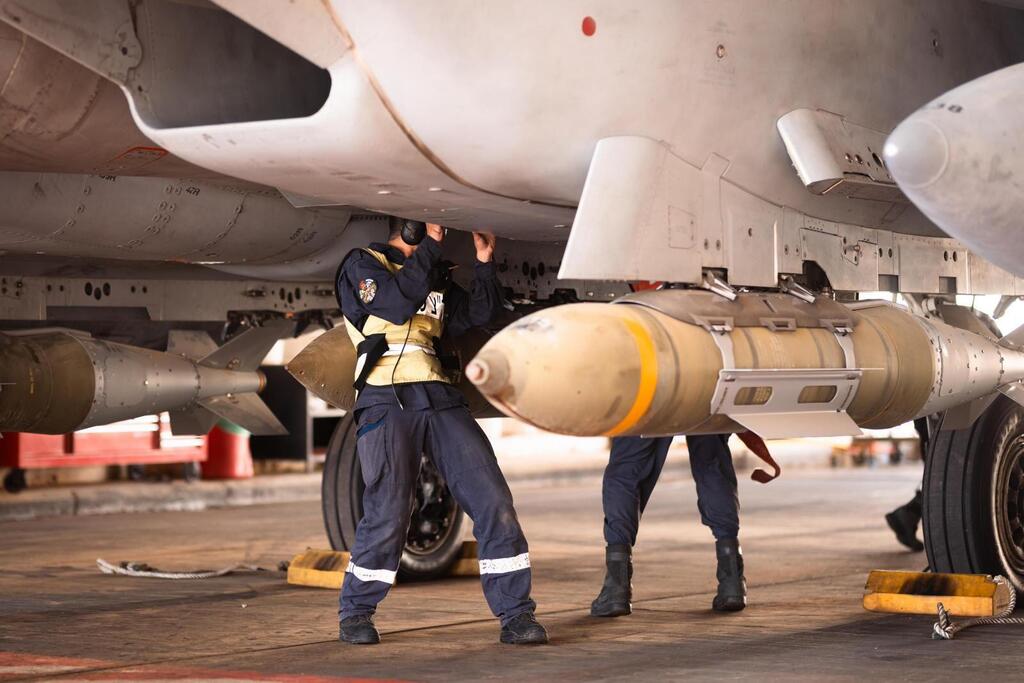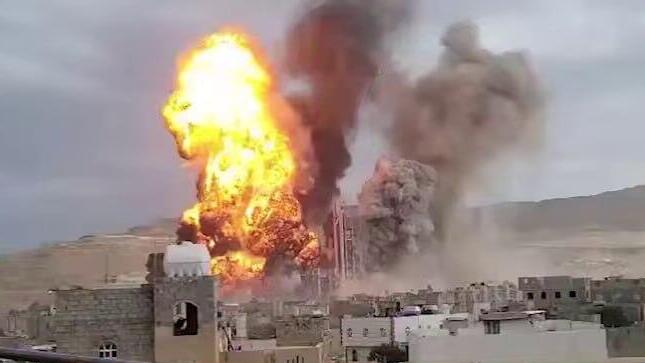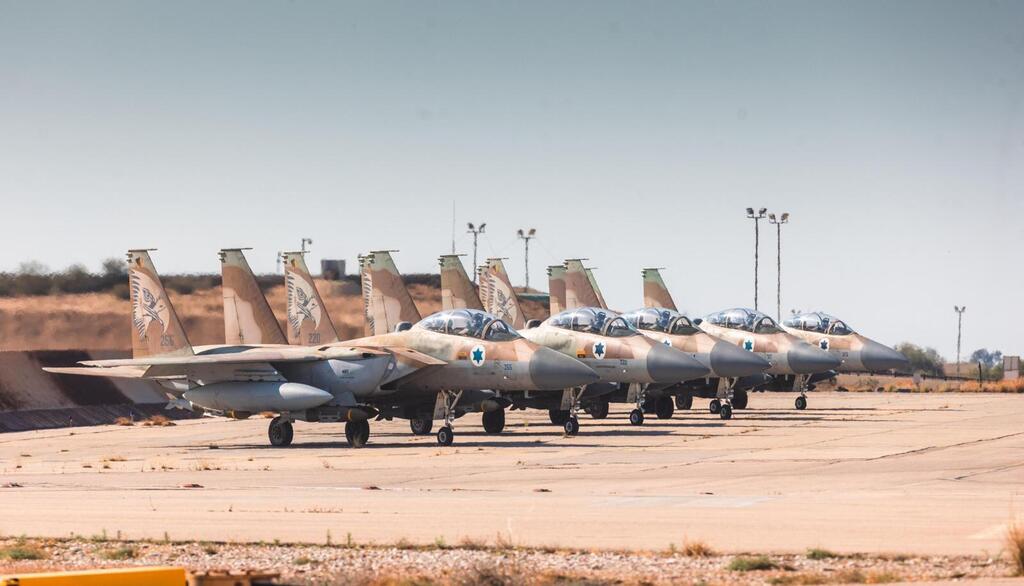A day and a half after a missile fired by the Houthis from Yemen exploded on the grounds of Ben Gurion International Airport, Israel announced the end of what it called an “era of restraint” and launched Operation Port City. On Monday, Israeli Air Force jets struck targets in the port of Hodeidah and an additional industrial facility in the area.
Israeli officials described the strike as a broad operation coordinated with the United States, which simultaneously announced it was halting its own campaign against the Houthis due to a ceasefire agreement—an agreement that does not apply to Israel. The following day, dozens of Israeli warplanes carried out additional strikes, this time in the capital Sanaa, causing extensive damage to Yemen’s central airport.
Aerial refueling of fighter jets en route to the strike in Yemen
(Video: IDF)
The strikes involved coordination between various IAF squadrons, using F-15, F-16 and F-35 “Adir” fighter jets, alongside refueling, intelligence and command-and-control aircraft. “They provided the support that enabled us to reach such a distant range,” said Maj. N., 25, the deputy commander of the 69th Squadron, who previously oversaw strike planning in Yemen and participated in this week’s operations.
More than half the personnel involved in Operation Port City—both air crews and the technical teams responsible for aircraft maintenance and armament—were reservists. According to Maj. N., the recent controversy over an open letter from pilots calling for the release of Israeli hostages, even at the cost of halting fighting, did not impact unit morale. “Reservists showed up in full force,” he said. “Those things don’t affect the squadron—we’re ready for anything.”
The strike, carried out roughly 1,200 miles from Israel—about a two-and-a-half-hour flight each way—involved some 50 different munitions. The targets hit included those from a designated target bank, as well as others added during the hours-long preparation for the mission.
Israeli airstrikes in Yemen
“Normally, preparation for such an operation takes several days, but this time it happened in a very short window,” said Maj. N. “From the moment the missile landed at Ben Gurion Airport, only a short time passed before we got the call to prepare for the strike. That adds complexity, but because we’ve rehearsed this scenario before, we were able to get ready quickly. Intelligence preparation is a major component of both planning and execution. The fact that this wasn’t our first operation in Yemen helped—but still, every time we go there, we discover new things.”
Operating in a relatively unfamiliar theater required taking into account potential threats from foreign militaries in the area. “We prepared for the possibility of being targeted and made every effort—both in planning and execution—to avoid that, and it worked,” he said. “On missions like these, sometimes the most dangerous part is simply the distance from home. Even the smallest malfunction can become a game-changer in terms of making it back safely to land in Israel. For those scenarios, we have detailed contingency plans and responses.”
“During the long flight, your focus is on the aircraft systems—monitoring all the data. You’re constantly checking timelines, fuel planning, exactly as trained, to make sure you can complete the mission and return,” he said. “The pride sets in once the mission is complete, but the real relief only comes when the plane touches down and you shut off the engines in the hangar. That’s when the tension finally releases. It’s something you learn to manage on long flights—you can’t let your guard down too early. You have to stay alert the whole time, because even after completing the mission, you still have a two-and-a-half-hour flight home.”
How does one mentally prepare for such a mission?
“There’s excitement before takeoff. What helps me is serious preparation—knowing exactly what needs to be done at every stage and what scenarios might arise. It’s a positive kind of pressure, the kind every combat pilot feels when entering hostile or enemy territory. The amazing thing is that the moment you enter the cockpit and launch the mission, you switch into a mode where there’s no room for emotion.”
'The war is not over'
For Capt. N., 25, a fighter pilot in the 69th Squadron, it was his first time operating over Yemen. “There’s extremely precise synchronization among everyone, down to the second,” he said. “An encounter—say, with a tanker or a jet from another squadron 800 km from home—has to happen at exactly the right time and place.
“Any malfunction that would be minor near home takes on much greater significance at that distance. A glitch could force us to change the plan on the spot or affect fuel—and when you’re far from home, that’s critical. So our preparation is more comprehensive, with detailed contingency plans and responses.”
How does a pilot stay sharp en route to such a mission?
“The communication is strictly professional. There’s almost no casual talk—that’s how we maintain operational focus. When you’re flying close to other aircraft, especially during refueling, you need to stay completely aware and oriented. You’re always thinking about the next moment,” said Y.
Operational planning, he explained, relied on high-level intelligence and included action plans for potential counterattacks. While the squadron maintains its combat readiness through years of training, the mission’s preparation took only a few hours. “We knew exactly what to do if we were threatened at any stage from any direction. We ran simulations in advance, down to minute details—including each crew member’s role in the formation,” he said.
What did he feel after the mission?
“On one hand, tremendous pride. I was honored to be given this responsibility. On the other hand, the war is not over. Hostages are still in captivity, forces are still fighting in Gaza. I’m now on standby to assist in Gaza. This was a localized success, but we keep pushing forward until we win.”
Destruction at Sanaa airport
(Video: Reuters)
Maj. S., a technical officer in the 69th Squadron, said the squadron had been preparing for two major operations simultaneously, forcing the maintenance units to split their efforts. “This kind of mission has huge implications—it’s not just another operation in our usual region,” he said. “When it’s a third-ring mission, aircraft maintenance is completely different. It requires outside experts to conduct deep checks on the planes.”
Get the Ynetnews app on your smartphone: Google Play: https://bit.ly/4eJ37pE | Apple App Store: https://bit.ly/3ZL7iNv
Under normal conditions, preparing the aircraft takes a day and a half to two days, but that timeline was significantly compressed. After thorough inspections, the jets performed a short test flight—a sort of dress rehearsal—before being armed and declared mission-ready. “Our strength lies in our people. Without them, this mission wouldn’t have succeeded,” he said. “It’s all thanks to the human fabric here—people who’ve been working day in, day out, for over a year and a half. It’s a privilege to witness. Tremendous pride.”
Lt. A., an intelligence officer who led the planning for the Yemen strikes, described the strategic aim behind the attack. “We wanted to return fire for fire. If they hit Ben Gurion, then they won’t have an airport in Sanaa,” she said. “Once the decision was made, we prioritized targets to try to shut down the airfield long-term and stop weapons transport operations there.”
Aircraft burning following the strike in Sanaa, Yemen
The first strike, carried out Monday night, hit the port of Hodeidah and a concrete plant. The following day’s operation struck Sanaa Airport, another concrete facility and power stations.
Y. monitored the mission in real time from the control center alongside the Air Force chief and senior command. “We saw the planes cross into enemy airspace live,” she recalled. “It was an incredible sense of accomplishment—and mostly relief when they landed safely. Once they crossed into Yemen, the threat level automatically rose. We’ve struck targets in Yemen before, but not with IAF jets directly over Yemeni soil. This time they were far more exposed.”
Are further strikes being planned?
“We’re always thinking ahead to the next campaign—whether in Yemen or elsewhere,” she said. “After each strike, we assess the results—how our targets affected their system and what kind of psychological impact we achieved.”









